Mohamed Hibat-Allah
Lattice Protein Folding with Variational Annealing
Feb 28, 2025Abstract:Understanding the principles of protein folding is a cornerstone of computational biology, with implications for drug design, bioengineering, and the understanding of fundamental biological processes. Lattice protein folding models offer a simplified yet powerful framework for studying the complexities of protein folding, enabling the exploration of energetically optimal folds under constrained conditions. However, finding these optimal folds is a computationally challenging combinatorial optimization problem. In this work, we introduce a novel upper-bound training scheme that employs masking to identify the lowest-energy folds in two-dimensional Hydrophobic-Polar (HP) lattice protein folding. By leveraging Dilated Recurrent Neural Networks (RNNs) integrated with an annealing process driven by temperature-like fluctuations, our method accurately predicts optimal folds for benchmark systems of up to 60 beads. Our approach also effectively masks invalid folds from being sampled without compromising the autoregressive sampling properties of RNNs. This scheme is generalizable to three spatial dimensions and can be extended to lattice protein models with larger alphabets. Our findings emphasize the potential of advanced machine learning techniques in tackling complex protein folding problems and a broader class of constrained combinatorial optimization challenges.
Recurrent neural network wave functions for Rydberg atom arrays on kagome lattice
May 30, 2024
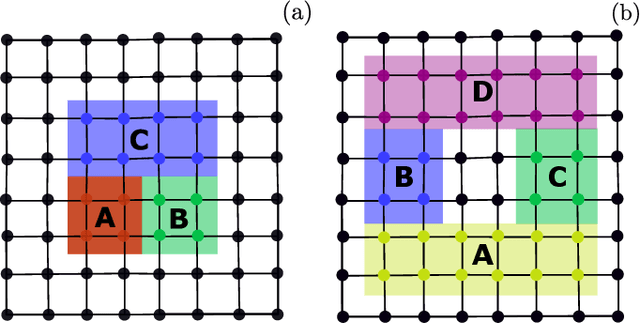
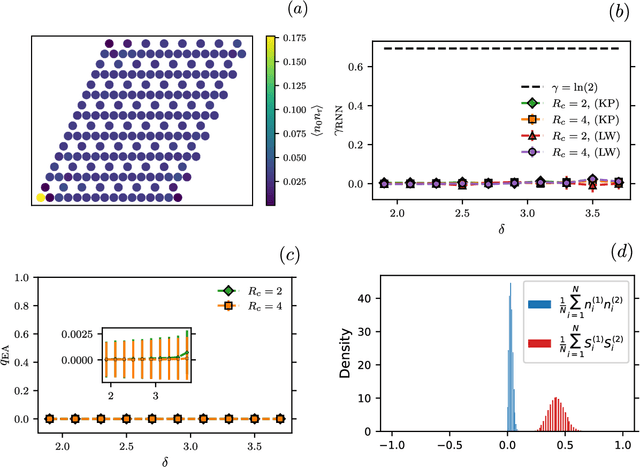
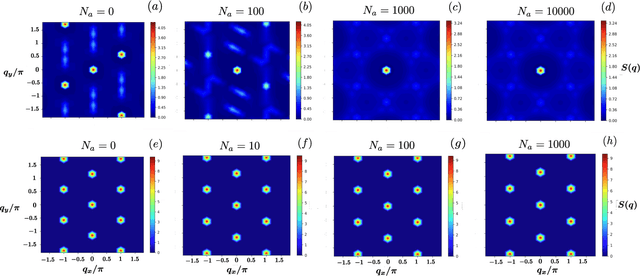
Abstract:Rydberg atom array experiments have demonstrated the ability to act as powerful quantum simulators, preparing strongly-correlated phases of matter which are challenging to study for conventional computer simulations. A key direction has been the implementation of interactions on frustrated geometries, in an effort to prepare exotic many-body states such as spin liquids and glasses. In this paper, we apply two-dimensional recurrent neural network (RNN) wave functions to study the ground states of Rydberg atom arrays on the kagome lattice. We implement an annealing scheme to find the RNN variational parameters in regions of the phase diagram where exotic phases may occur, corresponding to rough optimization landscapes. For Rydberg atom array Hamiltonians studied previously on the kagome lattice, our RNN ground states show no evidence of exotic spin liquid or emergent glassy behavior. In the latter case, we argue that the presence of a non-zero Edwards-Anderson order parameter is an artifact of the long autocorrelations times experienced with quantum Monte Carlo simulations. This result emphasizes the utility of autoregressive models, such as RNNs, to explore Rydberg atom array physics on frustrated lattices and beyond.
A Framework for Demonstrating Practical Quantum Advantage: Racing Quantum against Classical Generative Models
Mar 27, 2023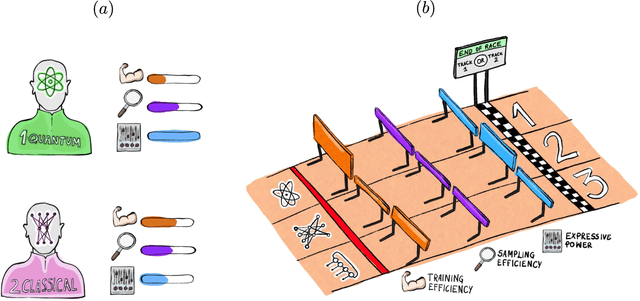
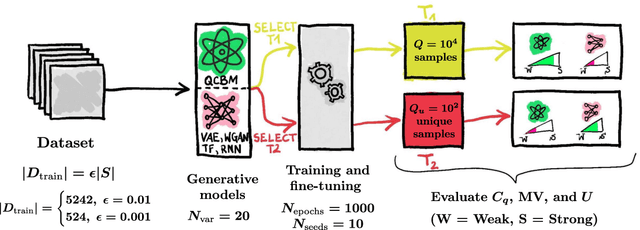

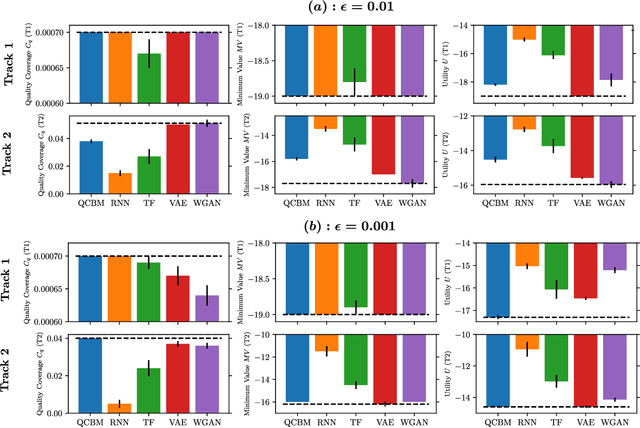
Abstract:Generative modeling has seen a rising interest in both classical and quantum machine learning, and it represents a promising candidate to obtain a practical quantum advantage in the near term. In this study, we build over a proposed framework for evaluating the generalization performance of generative models, and we establish the first quantitative comparative race towards practical quantum advantage (PQA) between classical and quantum generative models, namely Quantum Circuit Born Machines (QCBMs), Transformers (TFs), Recurrent Neural Networks (RNNs), Variational Autoencoders (VAEs), and Wasserstein Generative Adversarial Networks (WGANs). After defining four types of PQAs scenarios, we focus on what we refer to as potential PQA, aiming to compare quantum models with the best-known classical algorithms for the task at hand. We let the models race on a well-defined and application-relevant competition setting, where we illustrate and demonstrate our framework on 20 variables (qubits) generative modeling task. Our results suggest that QCBMs are more efficient in the data-limited regime than the other state-of-the-art classical generative models. Such a feature is highly desirable in a wide range of real-world applications where the available data is scarce.
Investigating Topological Order using Recurrent Neural Networks
Mar 26, 2023Abstract:Recurrent neural networks (RNNs), originally developed for natural language processing, hold great promise for accurately describing strongly correlated quantum many-body systems. Here, we employ 2D RNNs to investigate two prototypical quantum many-body Hamiltonians exhibiting topological order. Specifically, we demonstrate that RNN wave functions can effectively capture the topological order of the toric code and a Bose-Hubbard spin liquid on the kagome lattice by estimating their topological entanglement entropies. We also find that RNNs favor coherent superpositions of minimally-entangled states over minimally-entangled states themselves. Overall, our findings demonstrate that RNN wave functions constitute a powerful tool to study phases of matter beyond Landau's symmetry-breaking paradigm.
Quantum HyperNetworks: Training Binary Neural Networks in Quantum Superposition
Jan 19, 2023



Abstract:Binary neural networks, i.e., neural networks whose parameters and activations are constrained to only two possible values, offer a compelling avenue for the deployment of deep learning models on energy- and memory-limited devices. However, their training, architectural design, and hyperparameter tuning remain challenging as these involve multiple computationally expensive combinatorial optimization problems. Here we introduce quantum hypernetworks as a mechanism to train binary neural networks on quantum computers, which unify the search over parameters, hyperparameters, and architectures in a single optimization loop. Through classical simulations, we demonstrate that of our approach effectively finds optimal parameters, hyperparameters and architectural choices with high probability on classification problems including a two-dimensional Gaussian dataset and a scaled-down version of the MNIST handwritten digits. We represent our quantum hypernetworks as variational quantum circuits, and find that an optimal circuit depth maximizes the probability of finding performant binary neural networks. Our unified approach provides an immense scope for other applications in the field of machine learning.
Supplementing Recurrent Neural Network Wave Functions with Symmetry and Annealing to Improve Accuracy
Jul 28, 2022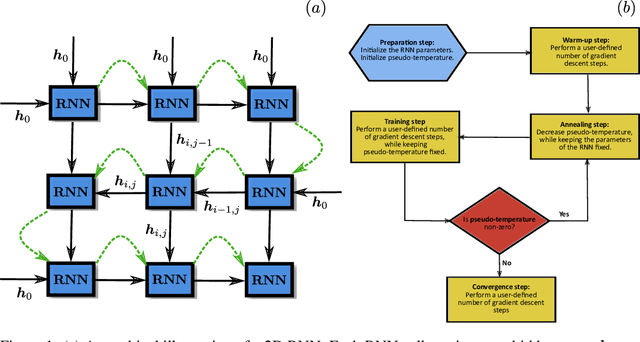
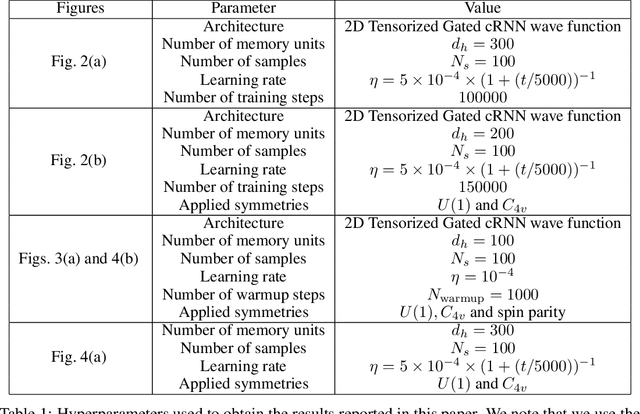

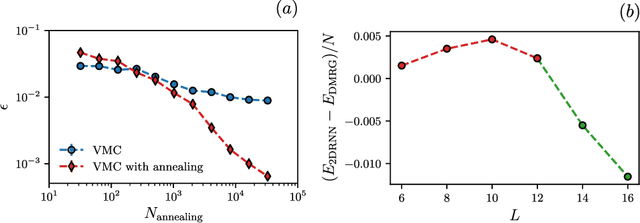
Abstract:Recurrent neural networks (RNNs) are a class of neural networks that have emerged from the paradigm of artificial intelligence and has enabled lots of interesting advances in the field of natural language processing. Interestingly, these architectures were shown to be powerful ansatze to approximate the ground state of quantum systems. Here, we build over the results of [Phys. Rev. Research 2, 023358 (2020)] and construct a more powerful RNN wave function ansatz in two dimensions. We use symmetry and annealing to obtain accurate estimates of ground state energies of the two-dimensional (2D) Heisenberg model, on the square lattice and on the triangular lattice. We show that our method is superior to Density Matrix Renormalisation Group (DMRG) for system sizes larger than or equal to $14 \times 14$ on the triangular lattice.
* 11 pages, 4 figures, 1 table. Originally published in Machine Learning and the Physical Sciences Workshop (NeurIPS 2021), see: https://ml4physicalsciences.github.io/2021/files/NeurIPS_ML4PS_2021_92.pdf. Our reproducibility code can be found on https://github.com/mhibatallah/RNNWavefunctions
Do Quantum Circuit Born Machines Generalize?
Jul 27, 2022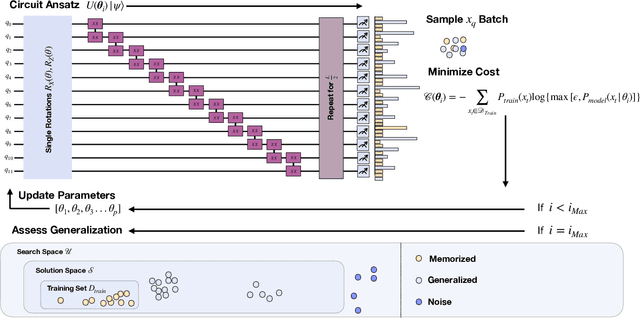
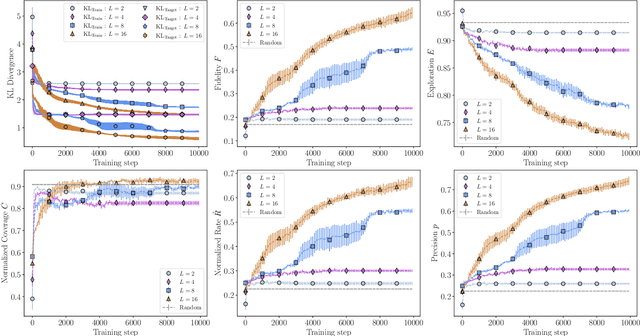
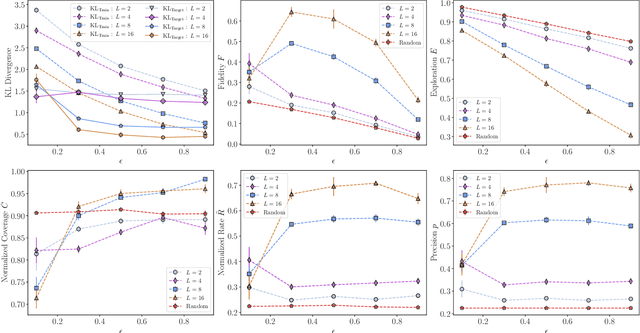

Abstract:In recent proposals of quantum circuit models for generative tasks, the discussion about their performance has been limited to their ability to reproduce a known target distribution. For example, expressive model families such as Quantum Circuit Born Machines (QCBMs) have been almost entirely evaluated on their capability to learn a given target distribution with high accuracy. While this aspect may be ideal for some tasks, it limits the scope of a generative model's assessment to its ability to memorize data rather than generalize. As a result, there has been little understanding of a model's generalization performance and the relation between such capability and the resource requirements, e.g., the circuit depth and the amount of training data. In this work, we leverage upon a recently proposed generalization evaluation framework to begin addressing this knowledge gap. We first investigate the QCBM's learning process of a cardinality-constrained distribution and see an increase in generalization performance while increasing the circuit depth. In the 12-qubit example presented here, we observe that with as few as 30% of the valid patterns as the training set, the QCBM exhibits the best generalization performance toward generating unseen and valid patterns. Lastly, we assess the QCBM's ability to generalize not only to valid features, but to high-quality bitstrings distributed according to an adequately biased distribution. We see that the QCBM is able to effectively learn the bias and generate unseen samples with higher quality than those in the training set. To the best of our knowledge, this is the first work in the literature that presents the QCBM's generalization performance as an integral evaluation metric for quantum generative models, and demonstrates the QCBM's ability to generalize to high-quality, desired novel samples.
Supplementing Recurrent Neural Networks with Annealing to Solve Optimization Problems
Jul 17, 2022



Abstract:Combinatorial optimization problems can be solved by heuristic algorithms such as simulated annealing (SA) which aims to find the global minima solution within a large search space through thermal fluctuations. The algorithm generates new solutions through Markov-chain Monte Carlo techniques. The latter can result in severe limitations, such as slow convergence and a tendency to stay within the same local search space at small temperatures. To overcome these shortcomings, we use the variational classical annealing (VCA) framework that combines autoregressive recurrent neural networks (RNNs) with traditional annealing to sample solutions independent of each other. In this paper, we demonstrate the potential of using VCA as an approach to solving real-world optimization problems. We explore VCA's performance in comparison with SA at solving three popular optimization problems: the maximum cut problem (Max-Cut), the nurse scheduling problem (NSP), and the traveling salesman problem (TSP). For all three problems, we find that VCA outperforms SA on average in the asymptotic limit. Interestingly, we reach large system sizes up to $256$ cities for the TSP. We conclude that in the best-case scenario, VCA can serve as a great alternative when SA fails to find the optimal solution.
Variational Neural Annealing
Jan 25, 2021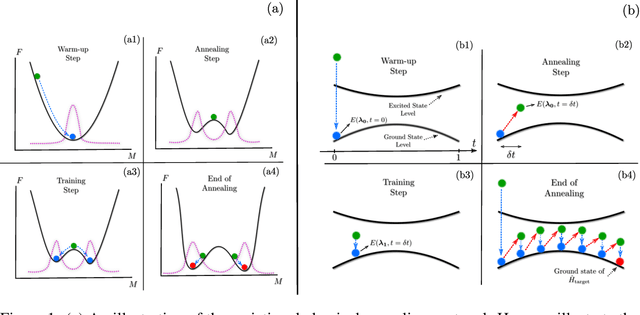
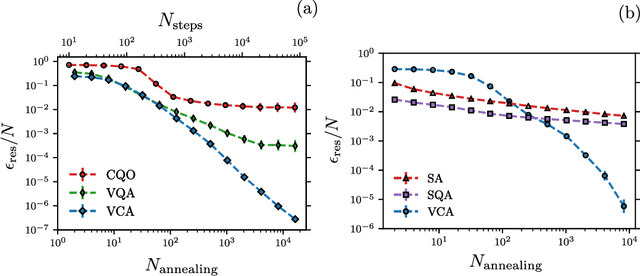
Abstract:Many important challenges in science and technology can be cast as optimization problems. When viewed in a statistical physics framework, these can be tackled by simulated annealing, where a gradual cooling procedure helps search for groundstate solutions of a target Hamiltonian. While powerful, simulated annealing is known to have prohibitively slow sampling dynamics when the optimization landscape is rough or glassy. Here we show that by generalizing the target distribution with a parameterized model, an analogous annealing framework based on the variational principle can be used to search for groundstate solutions. Modern autoregressive models such as recurrent neural networks provide ideal parameterizations since they can be exactly sampled without slow dynamics even when the model encodes a rough landscape. We implement this procedure in the classical and quantum settings on several prototypical spin glass Hamiltonians, and find that it significantly outperforms traditional simulated annealing in the asymptotic limit, illustrating the potential power of this yet unexplored route to optimization.
 Add to Chrome
Add to Chrome Add to Firefox
Add to Firefox Add to Edge
Add to Edge